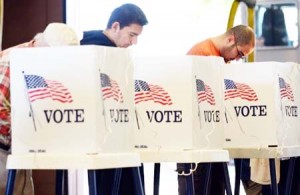Arab News
MICHAEL J. BOSKIN
 Big changes are underway in the United States, as the country gears up to elect a new president, one-third of the Senate, and the entire House of Representatives this November. The outcome will have profound consequences for US economic policy, and thus for the global economy.
Big changes are underway in the United States, as the country gears up to elect a new president, one-third of the Senate, and the entire House of Representatives this November. The outcome will have profound consequences for US economic policy, and thus for the global economy.
As it stands, Hillary Clinton remains the front-runner for the Democratic nomination, though she has not yet pulled away from her socialist opponent, Sen. Bernie Sanders. The bombastic billionaire Donald Trump is leading the Republican field, followed by firebrand Sen. Ted Cruz of Texas, Sen. Marco Rubio, a talented mainstream conservative from Florida, and, further back, popular Ohio Gov. John Kasich and neurosurgeon Ben Carson.
It is impossible to know whether these early trends will hold through the rest of the primaries, now turning to the South and Midwest. America’s media and political junkies are consumed by the various possibilities. Can Rubio rally a broad coalition, or will Trump win the Republican nomination? Would a Trump nomination help Clinton win the general election?
In fact, many Republicans fear a contest pitting Trump against Clinton. Though Clinton has plenty of weaknesses, the nasty infighting among Republicans may give her a big advantage in November. Many Republicans believe that Trump’s nomination would cost them the Senate and the White House.
With so much uncertainty, there are a number of directions that US policy could take in the coming years. American voters are highly concerned about economic issues — concerns that the leading candidates would address in very different ways. On trade, Trump’s ideas are dangerous and would reverse decades of beneficial bipartisan American leadership in trade liberalization, with large tariffs on foreign imports, such as from China and Mexico. The other Republican candidates barely discuss the topic. As for the Democrats, Sanders inveighs against free trade. Clinton has flip-flopped on the issue.
Clinton has also inched toward Sanders’s position on financial-system reform, as his attacks on her for taking large donations and speaking fees from Wall Street have clearly struck a chord among young voters. Confronting the big-bank bogeyman has been a centerpiece of Sanders’ campaign; Clinton is now partly echoing his populist anti-bank positions. The Democrats favor loose monetary policy, low interest rates, and a depreciated dollar. Republicans also oppose bailouts, but worry about excessively loose monetary policy and too much discretion for the US Federal Reserve outside real emergencies.
These differences will have a far-reaching impact. By appointing a new Fed Chair (or reappointing Janet Yellen), and possibly other Fed governors, the next president will have an indirect influence on interest rates, exchange rates and global financial markets. If inflationary pressures rise the Fed’s response will be a key determinant of economic stability.
The candidates also differ enormously in their tax and spending plans — and thus their deficit and debt proposals. Sanders is proposing about $18 trillion of additional spending over the next decade to cover a single-payer health-care system, infrastructure investment, and “free” (that is, taxpayer-paid) tuition at public colleges. During that period, he would impose tax hikes of $6.5 trillion, mostly on the “wealthy.” The catch: Democrats define “wealthy” as an annual household income above $250,000 — roughly the starting salary of an urban couple in their first jobs after law school. The $11.5 trillion deficit would eventually have to be covered by a gigantic future tax hike. Clinton has similar spending and tax priorities, though with smaller increases.
The Republicans want to lower personal income tax rates and broaden the tax base. They would reduce America’s corporate-tax rate — the highest in the OECD — to a far more competitive level. Some propose replacing the current personal and corporate income taxes with a flat tax on consumption.
The empirical evidence suggests that tax cuts are more likely than spending increases to spur growth, and that lower spending is more likely than tax hikes to consolidate budgets effectively. While past experience indicates that constraining spending growth will not be easy, especially with the aging of the post-1945 baby-boom generation fueling rising health-care and pension costs, many countries —including Canada, the UK, Sweden and even the US itself — have managed to do so in recent decades.
Republicans and Democrats differ starkly on reforming exploding entitlement costs, which have unfunded liabilities several times the national debt. The Republicans — with the exception of Trump, who rejects future Social Security “cuts” — would gradually slow growth, whereas the Democrats propose increasing Social Security benefits. The next leader of the free world should know that when a ship starts leaking, the first priority is to plug the leak, not open new ones.
Overall, the policies proposed by Sanders and Clinton would take the US closer to a European-style social-welfare state. But, as Republicans point out, Western Europe’s standard of living is 30 percent lower than that of the US, on average. That is why Republican candidates want to roll back President Obama’s tax and spending increases, expensive health-care reform, and regulatory overreach.




